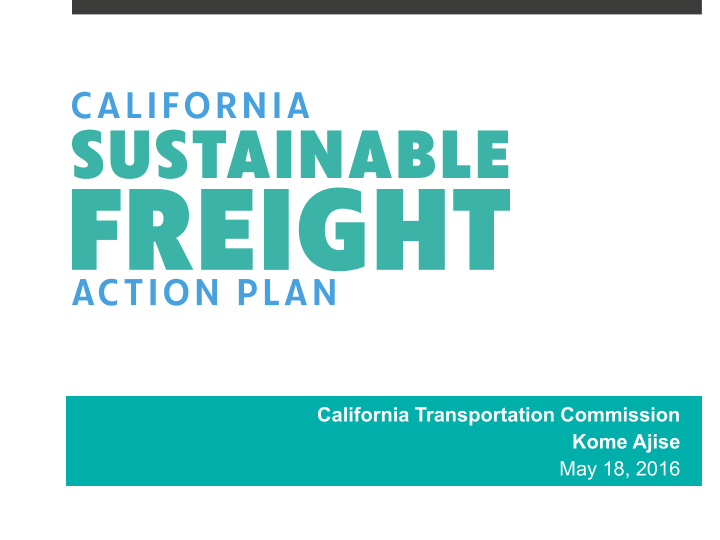



California Transportation Commission Kome Ajise May 18, 2016
Overview • California’s Freight Transport System • Governor’s Executive Order B-32-15 • Components of the Action Plan • Process and Next Steps 2
1/3 of California’s Jobs and Economy California Industry Employment Composition Total Employment (2014): 16 Million Retail Trade 10% Total Farm, 3% Mining, Logging & Manufacturing 8% Construction, 4% Manufacturing, Wholesale Trade 5% 8% Transportation Wholesale Mining, Logging, & Other Industries 4% Freight-related & trade, 5% Construction 67% Industries Retail Trade, Warehousing, 33% Transportation & 3% 10% 3% Warehousing Utilities, 0.4% Farm 3% Utilities 0.4% Source: EDD, Labor Market Information Division, 2014 3
Freight Is Important to California’s Economy Freight-dependent industries account for: • Over $740B of CA Gross Domestic Product, 32% of the California economy (2014) • Over 5 million jobs, 33% of California jobs (2014) California freight projections for 2025: • 25% increase in volume • 60% increase in commodity value Projects Source: Freight Analysis Framework Data by U.S. Dept. of Transportation 2012 4
2/3 of Freight Transport Within 2/3 of Freight Transport Within California California 13 % 4 % 61 % 22 % • Source: Freight Analysis Framework Data by U.S. Department of Transportation, 2015 5
Under Continuous Pressure to Evolve • 25 percent increase in volume by 2025 • Competition and cost pressures • Demands of e-commerce • System capacity, safety, and security • More protective toxics and air quality standards • Increased vulnerability of freight facilities to climate change impacts 6
Progress Will Require Partnerships Across… • Multiple sectors, disciplines, and organizations • State government • Industry • Environmental and community partners • Federal, regional, and local agencies • International bodies 7
Governor’s Executive Order B-32-15 Multi-decade, iterative process needed to transform California’s freight system. State agencies, in consultation with stakeholders, to develop plan by July 2016 to: • Improve freight efficiency • Transition to zero emission technologies • Increase competitiveness 8
Other Recent State Plans 9
Stakeholder Engagement Public Workshops and Webinars • July 2015 • October 2015 • January-February 2016 Individual and Stakeholder Group Meetings • California Freight Advisory Committee • Freight Efficiency Working Group • California Cleaner Freight Coalition • Tribal governments • Other groups as requested 10
Freight Efficiency Working Group Chaired by Dr. Sperling and Convened by Caltrans • Participants: Freight industry, academics, advocates, and government • Developed a series of white papers: o Funding for Freight Infrastructure and Clean Equipment o Strategies to Maximize Asset Utilization o Planning and Policy o Operational Modernization at Distribution Nodes o Information Technology 11
Framework of Draft Action Plan Released on May 3, includes: • 2050 Freight System Vision • Guiding Principles • 2030 Statewide Targets • Freight Funding Approach • State Agency Actions • Pilot Projects • Discussion Concepts 12
2030 Statewide Targets • System Efficiency: Improve 25 percent by 2030 • Technology: Deploy over 100,000 zero emission vehicles/equipment and maximize near-zero by 2030 • Economy: Foster future economic growth within the freight and goods movement industry 13
Investing in California’s Freight Transport System • Potential Freight Funding o Fixing America’s Surface Transportation (FAST) Act o Governor Brown’s Fiscal Year 2016-2017 Budget Proposal • Approach to Ongoing Freight Investments o Trade Corridor Improvement Fund/Goods Movement Emission Reduction Program – Phase II o Further explore matching grants, financing assistance, and bulk purchasing power 14
State Agency Actions 1. Work with legislature on a freight transport funding package 2. Work with legislature on distribution of federal FAST Act funds 3. Plan and invest in infrastructure to modernize freight corridors 4. Accelerate use of advanced technologies and renewable fuels 15
State Agency Actions (cont’d) 5. Establish a sustainable freight think tank 6. Develop strategies, tools, and data that considers commercial viability and promotes competitiveness 7. Continue work with the freight efficiency development group 8. Implement steps to meet existing and future workforce needs 9. Identify regulatory or permitting process improvements 16
Pilot Projects • Dairy Biogas for Freight Vehicles San Joaquin Valley • Advanced Technology for Truck Corridors Southern California • Advanced Technology Corridors at Border Ports of Entry California-Mexico Border 17
Discussion Concepts • Inland marine corridors • Non-traditional transport methodologies • Packaging optimization • Supply chain consolidation in the agricultural industry • System efficiency strategies • Transportation projects • Interstate 710 Corridor • State Route 11 Otay Mesa East Port of Entry 18
Action Plan Timeline May 3, 2016 Draft Plan Released for Public Comment May 10, 2016 California Freight Advisory Committee May 18, 2016 CTC Meeting May 19, 2016 ARB Board Meeting July 6, 2016 End of Public Comment July 2016 Finalize and submit to Governor View the full draft Action Plan at: www.casustainablefreight.org 19
Recommend
More recommend